Performance of Mortars with Commercially-Available Reactive Magnesium Oxide as Alternative Binder
Abstract
1. Introduction
2. Experimental Program
2.1. Tests
2.2. Materials
2.3. Mix Design
3. Results and Discussion
3.1. Fresh Mortar Properties
3.2. Hardened State Properties
3.2.1. Compressive Strength
3.2.2. Flexural Strength
3.2.3. Dynamic Modulus of Elasticity
3.2.4. Ultrasonic Pulse Velocity
3.2.5. Water Absorption by Capillarity
3.2.6. Shrinkage
4. Conclusions
Author Contributions
Funding
Institutional Review Board Statement
Informed Consent Statement
Data Availability Statement
Acknowledgments
Conflicts of Interest
References
- Lutz, W.; Sanderson, W.; Scherbov, S. The end of world population growth. Nature 2001, 412, 543–545. [Google Scholar] [CrossRef] [PubMed]
- Bongaarts, J. United Nations, department of economic and social affairs, population division, sex differentials in childhood mortality. Popul. Dev. Rev. 2014, 40, 380. [Google Scholar] [CrossRef]
- Betts, M.; Robinson, G.; Burton, C.; Leonard, J.; Sharda, A.; Whittington, T.G.C.P.; Economics, O. Global Construction 2030: A Global Forecast for the Construction Industry to 2030; Global Construction Perspectives and Oxford Economics: London, UK, 2015. [Google Scholar]
- Thibaut, A.; John, D.; Ian, H.; Maxine, J.; Aparna, P.; Unep, I. 2019 Global Status Report for Building and Construction: Towards a Zero-Emission, Efficient and Resilient Buildings and Construction Sector; Unite Nations Environment Programme: Nairobi, Kenya, 2019. [Google Scholar]
- Andrew, R.M. Global CO2 emissions from cement production. Earth Syst. Sci. Data 2018, 10, 195. [Google Scholar] [CrossRef]
- Sinka, M.; Van den Heede, P.; De Belie, N.; Bajare, D.; Sahmenko, G.; Korjakins, A. Comparative life cycle assessment of magnesium binders as an alternative for hemp concrete. Resour. Conserv. Recycl. 2018, 133, 288–299. [Google Scholar] [CrossRef]
- Dung, N.T.; Unluer, C. Performance of reactive MgO concrete under increased CO2 dissolution. Cem. Concr. Res 2019, 118, 92–101. [Google Scholar] [CrossRef]
- José, N.; Ahmed, H.; Miguel, B.; Luís, E.; Jorge, D.B. Magnesia (MgO) Production and Characterization, and Its Influence on the Performance of Cementitious Materials: A Review. Materials 2020, 13, 4752. [Google Scholar] [CrossRef]
- Du, C. A review of magnesium oxide in concrete. Concr. Int. 2005, 27, 45–50. [Google Scholar]
- Al-Tabbaa, A. Eco-Efficient Concrete: 19. Reactive Magnesia Cement; Elsevier Inc.: Cambridge, UK, 2013. [Google Scholar]
- Mo, L.; Deng, M.; Tang, M.; Al-Tabbaa, A. MgO expansive cement and concrete in China: Past, present and future. Cem. Concr. Res 2014, 57, 1–12. [Google Scholar] [CrossRef]
- Zhang, S.; Lee, W. Spinel-containing refractories. In Refractories Handbook; CRC Press/Taylor & Francis: Boca Raton, FL, USA, 2004; p. 215. [Google Scholar]
- Walling, S.A.; Provis, J.L. Magnesia-based cements: A journey of 150 years, and cements for the future? Chem. Rev. 2016, 116, 4170–4204. [Google Scholar] [CrossRef] [PubMed]
- Zheng, L.; Xuehua, C.; Mingshu, T. MgO-type delayed expansive cement. Cem. Concr. Res. 1991, 21, 1049–1057. [Google Scholar] [CrossRef]
- Abdalqader, A.; Al-Tabbaa, A. Mechanical and Microstructural Characterisation of Multicomponent Blended Cements Incorporating Reactive Magnesia. In Proceedings of the 1st Concr. Innov. Cnference (CIC), Oslo, The Norwegian Concrete Association–Norsk Betongforening, Oslo, Norway, 10–13 June 2014; pp. 11–13. [Google Scholar]
- Mo, L.; Zhang, F.; Deng, M. Effects of carbonation treatment on the properties of hydrated fly ash-MgO-Portland cement blends. Constr. Build. Mater. 2015, 96, 147–154. [Google Scholar] [CrossRef]
- Mo, L.; Liu, M.; Al-Tabbaa, A.; Deng, M.; Lau, W.Y. Deformation and mechanical properties of quaternary blended cements containing ground granulated blast furnace slag, fly ash and magnesia. Cem. Concr. Res. 2015, 71, 7–13. [Google Scholar] [CrossRef]
- Mo, L.; Liu, M.; Al-Tabbaa, A.; Deng, M. Deformation and mechanical properties of the expansive cements produced by inter-grinding cement clinker and MgOs with various reactivities. Constr. Build. Mater. 2015, 80, 1–8. [Google Scholar] [CrossRef]
- Choi, S.-W.; Jang, B.-S.; Kim, J.-H.; Lee, K.-M. Durability characteristics of fly ash concrete containing lightly-burnt MgO. Constr. Build. Mater. 2014, 58, 77–84. [Google Scholar] [CrossRef]
- Mavroulidou, M.; Morrison, T.; Unsworth, C.; Gunn, M. Properties of concrete made of multicomponent mixes of low-energy demanding binders. Constr. Build. Mater. 2015, 101, 1122–1141. [Google Scholar] [CrossRef]
- Gao, P.W.; Wu, S.X.; Lu, X.L.; Deng, M.; Lin, P.H.; Wu, Z.R.; Tang, M.S. Soundness evaluation of concrete with MgO. Constr. Build. Mater. 2007, 21, 132–138. [Google Scholar] [CrossRef]
- Cao, F.; Yan, P. The influence of the hydration procedure of MgO expansive agent on the expansive behavior of shrinkage-compensating mortar. Constr. Build. Mater. 2019, 202, 162–168. [Google Scholar] [CrossRef]
- Moradpour, R.; Taheri-Nassaj, E.; Parhizkar, T.; Ghodsian, M. The effects of nanoscale expansive agents on the mechanical properties of non-shrink cement-based composites: The influence of nano-MgO addition. Compos. Part. B Eng. 2013, 55, 193–202. [Google Scholar] [CrossRef]
- Lau, W.Y. The Role of Reactive MgO as an Expansive Additive in the Shrinkage Reduction of Concrete. Ph.D. Thesis, University of Cambridge, London, UK, 27 April 2019. [Google Scholar]
- Pu, L.; Unluer, C. Investigation of carbonation depth and its influence on the performance and microstructure of MgO cement and PC mixes. Constr. Build. Mater. 2016, 120, 349–363. [Google Scholar] [CrossRef]
- Gonçalves, T.; Silva, R.; de Brito, J.; Fernández, J.; Esquinas, A. Mechanical and durability performance of mortars with fine recycled concrete aggregates and reactive magnesium oxide as partial cement replacement. Cem. Concr. Compos. 2020, 105, 103420. [Google Scholar] [CrossRef]
- Jiangxiong, W.; Yimin, C.; Yongxin, L. The reaction mechanism between MgO and microsilica at room temperature. J. Wuhan Univ. Technol. Mater. Sci. Ed. 2006, 21, 88–91. [Google Scholar] [CrossRef]
- Dung, N.; Unluer, C. Improving the performance of reactive MgO cement-based concrete mixes. Constr. Build. Mater. 2016, 126, 747–758. [Google Scholar] [CrossRef]
- Kazemian, F.; Rooholamini, H.; Hassani, A. Mechanical and fracture properties of concrete containing treated and untreated recycled concrete aggregates. Constr. Build. Mater. 2019, 209, 690–700. [Google Scholar] [CrossRef]
- BS EN 1015-3, Methods of Test for Mortar for Masonry–Part 3: Determination of Consistence of Fresh Mortar (by Flow Table); British Standard: London, UK, 1999.
- EN 1015-6, Methods of Test for Mortar for Masonry-Part 6: Determination of Bulk Density of Fresh Mortar; European Standard: Brussels, Belgium, 1998.
- EN 1015-11, Methods of Test for Mortar for Masonry–Part 11: Determination of Flexural and Compressive Strength of Hardened Mortar; European Committee for Standardization: Brussels, Belgium, 1999.
- EN 15317, Non-Destructive Testing—Ultrasonic Testing—Characterization and Verification of Ultrasonic Thickness Measuring Equipment; European Standard: Brussels, Belgium, 2013.
- ASTM E1876-15, Standard Test Method for Dynamic Young’s Modulus, Shear Modulus, and Poisson’s Ratio by Impulse Excitation of Vibration; ASTM International: West Conshohocken, PA, USA, 2015.
- EN 1015-18, Methods of Test for Mortar for Masonry-Determination of Water Absorption Coefficient Due to Capillarity Action of Hardened Mortar; European Standard: Brussels, Belgium, 2002.
- EN 1015-13, C.p. Draft European Standard—Methods of Test for Mortar for Masonry—Part 13. In Determination Dimensional Stability of Hardened Mortars; European Standard: Brussels, Belgium, 1993.
- BS EN 12620, Aggregates for Concrete; British Standard: London, UK, 2013.
- Hewlett, P.; Liska, M. Lea’s Chemistry of Cement and Concrete; Butterworth-Heinemann: Oxford, UK, 2019. [Google Scholar]
- Nepomuceno, M.; Oliveira, L.; Lopes, S.M.R. Methodology for mix design of the mortar phase of self-compacting concrete using different mineral additions in binary blends of powders. Constr. Build. Mater. 2012, 26, 317–326. [Google Scholar] [CrossRef]
- Yedra, E.; Ferrández, D.; Morón, C.; Gómez, E. New System to Determine the Evolution of the Dynamic Young’s Modulus from Early Ages in Masonry Mortars. Appl. Sci. 2020, 10, 8129. [Google Scholar] [CrossRef]
- Lafhaj, Z.; Goueygou, M.; Djerbi, A.; Kaczmarek, M. Correlation between porosity, permeability and ultrasonic parameters of mortar with variable water/cement ratio and water content. Cem. Concr. Res. 2006, 36, 625–633. [Google Scholar] [CrossRef]
- Godinho, J.P.; de Souza Júnior, T.; Medeiros, M.H.F.; Silva, M.A. Factors influencing ultrasonic pulse velocity in concrete. Rev. Ibracon De Estrut. E Mater. 2020, 13, 222–247. [Google Scholar] [CrossRef]
- Mo, L.; Panesar, D.K. Effects of accelerated carbonation on the microstructure of Portland cement pastes containing reactive MgO. Cem. Concr. Res. 2012, 42, 769–777. [Google Scholar] [CrossRef]
- Zhang, R.; Panesar, D.K. Water absorption of carbonated reactive MgO concrete and its correlation with the pore structure. J. Co2 Util. 2018, 24, 350–360. [Google Scholar] [CrossRef]
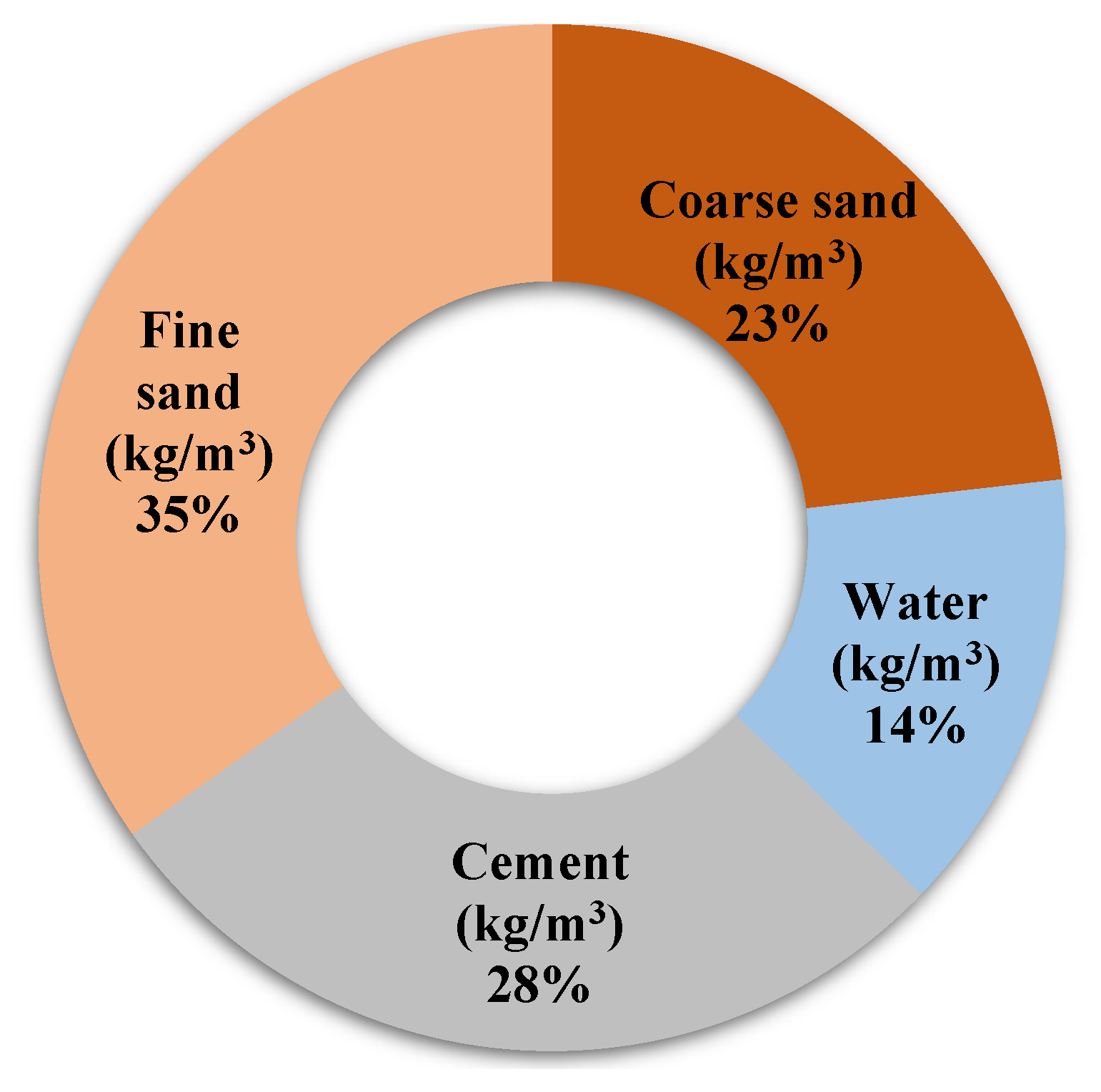
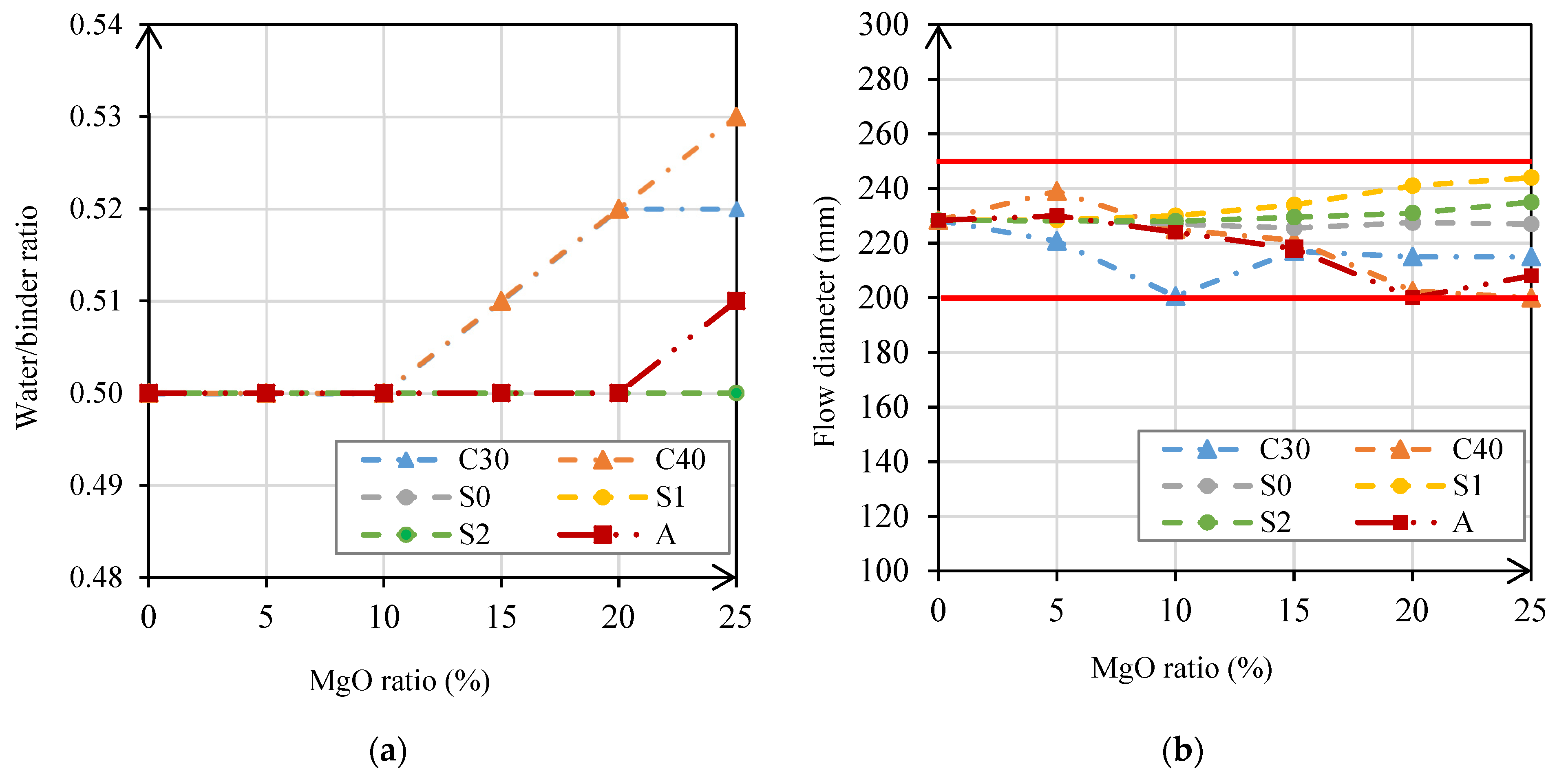
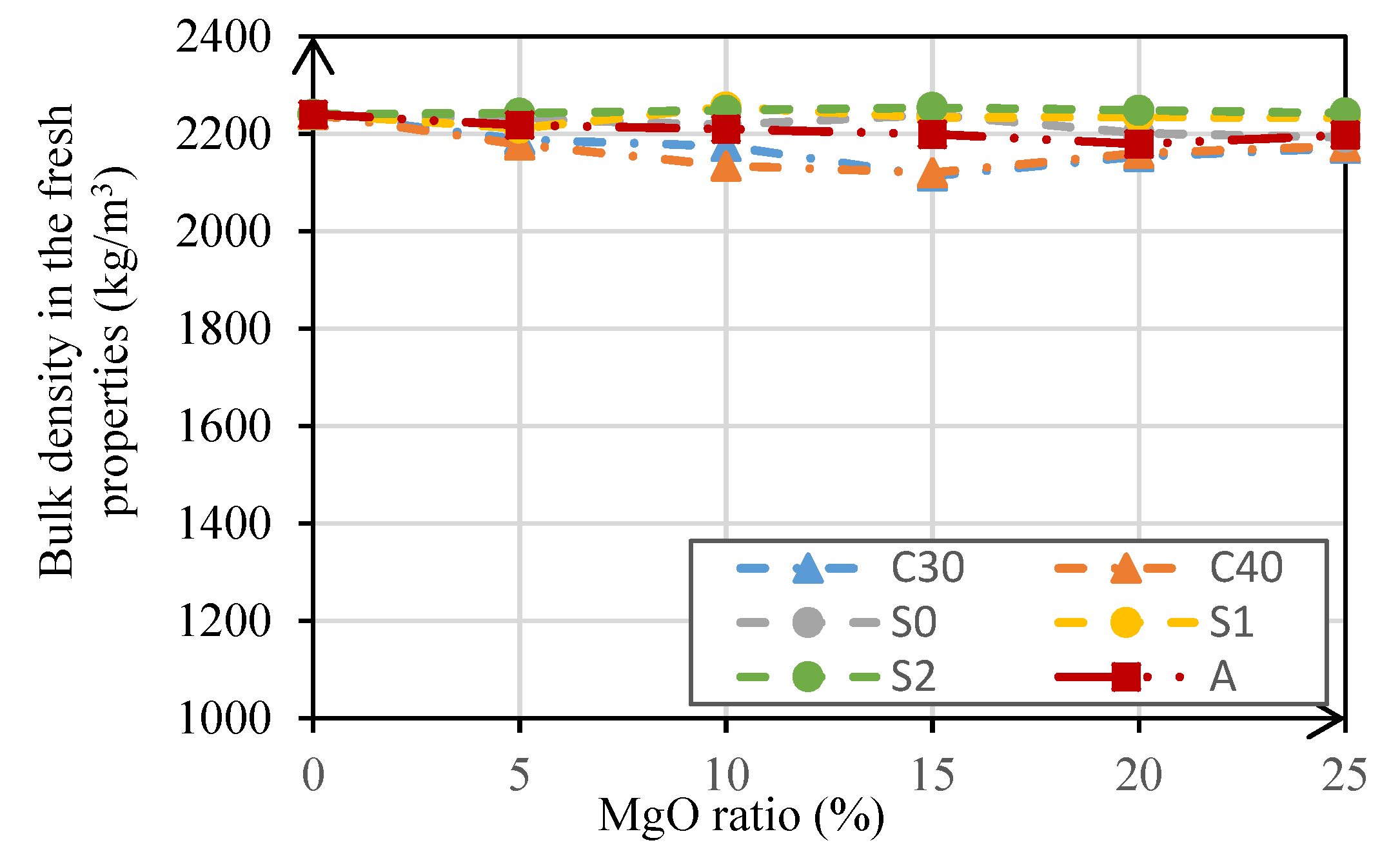
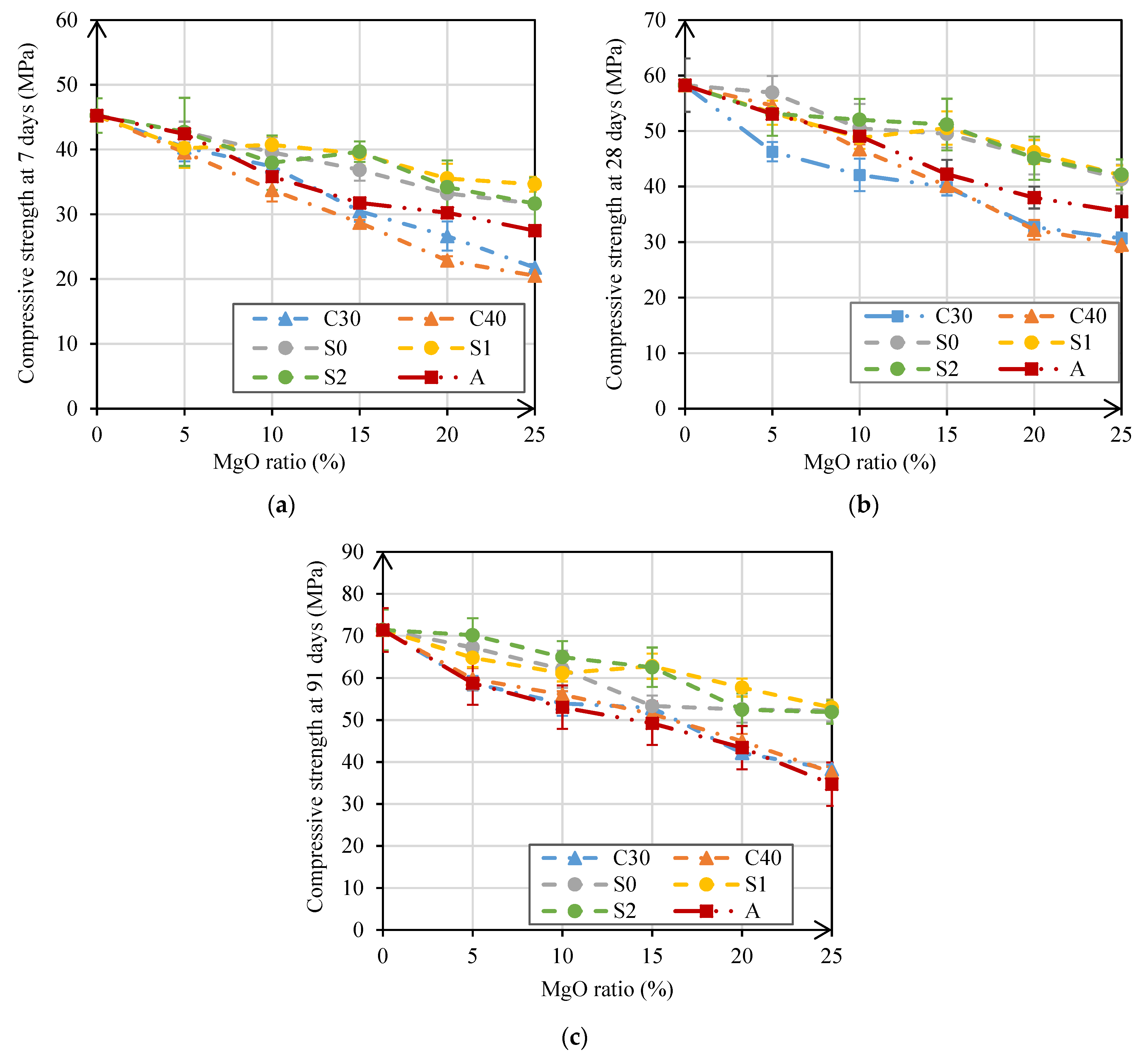
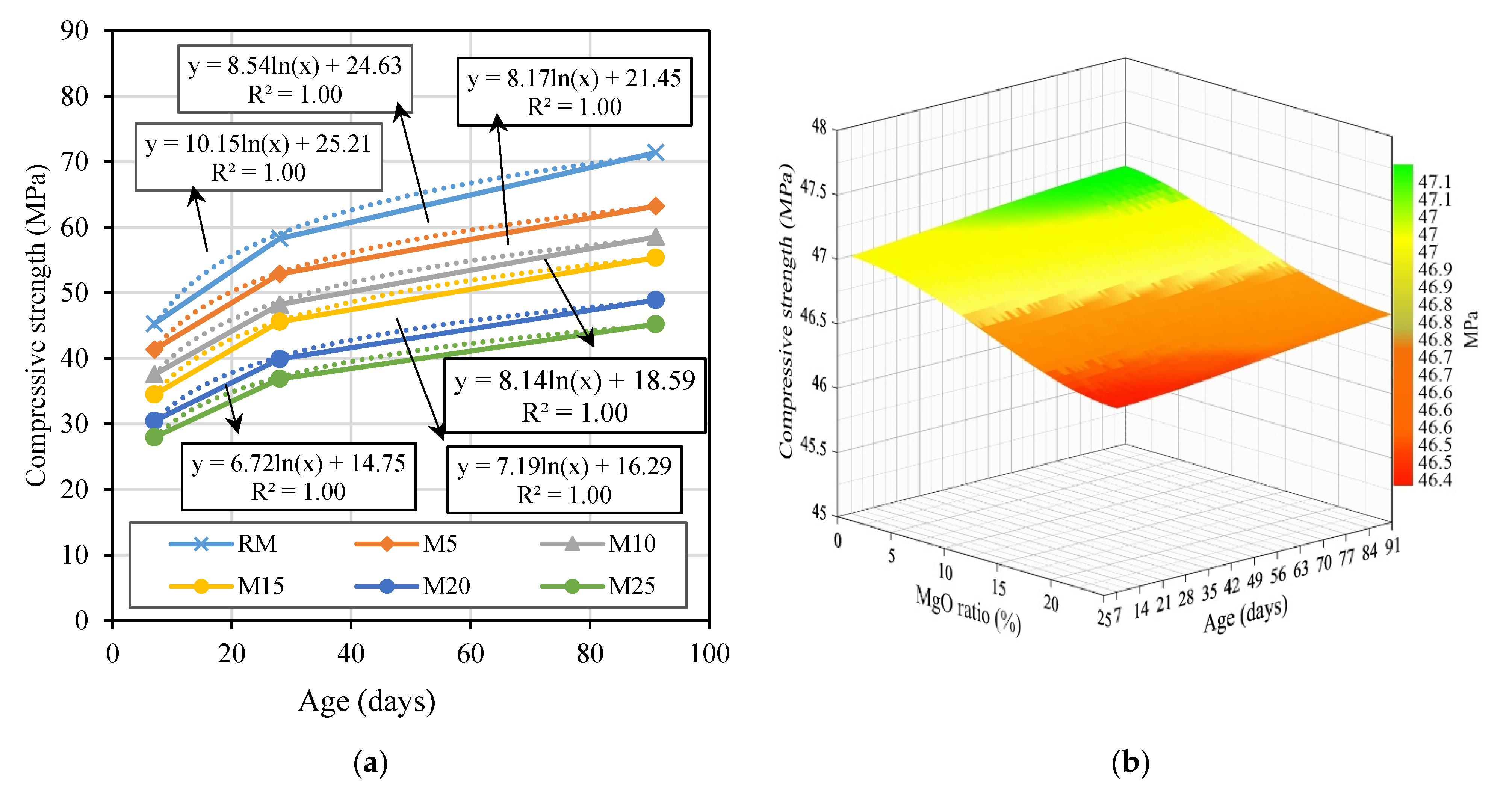


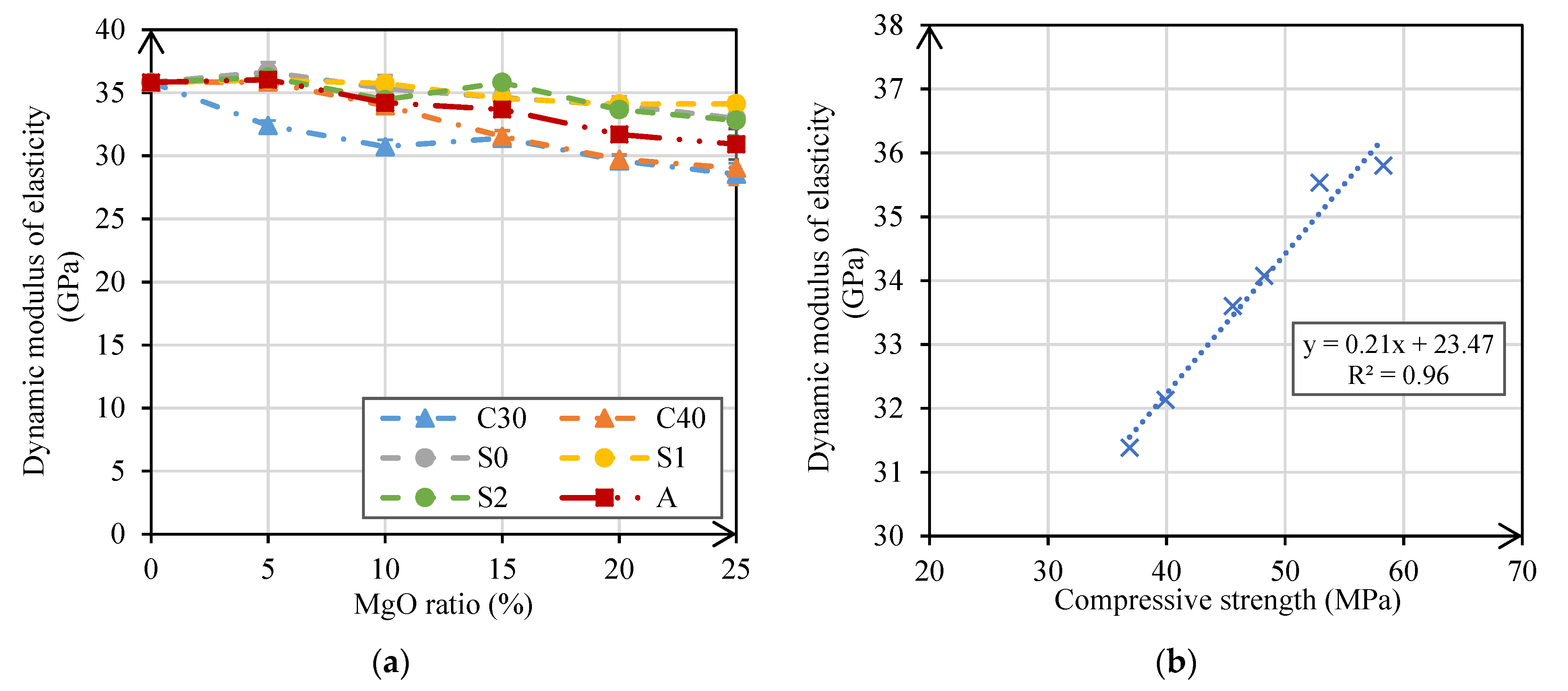
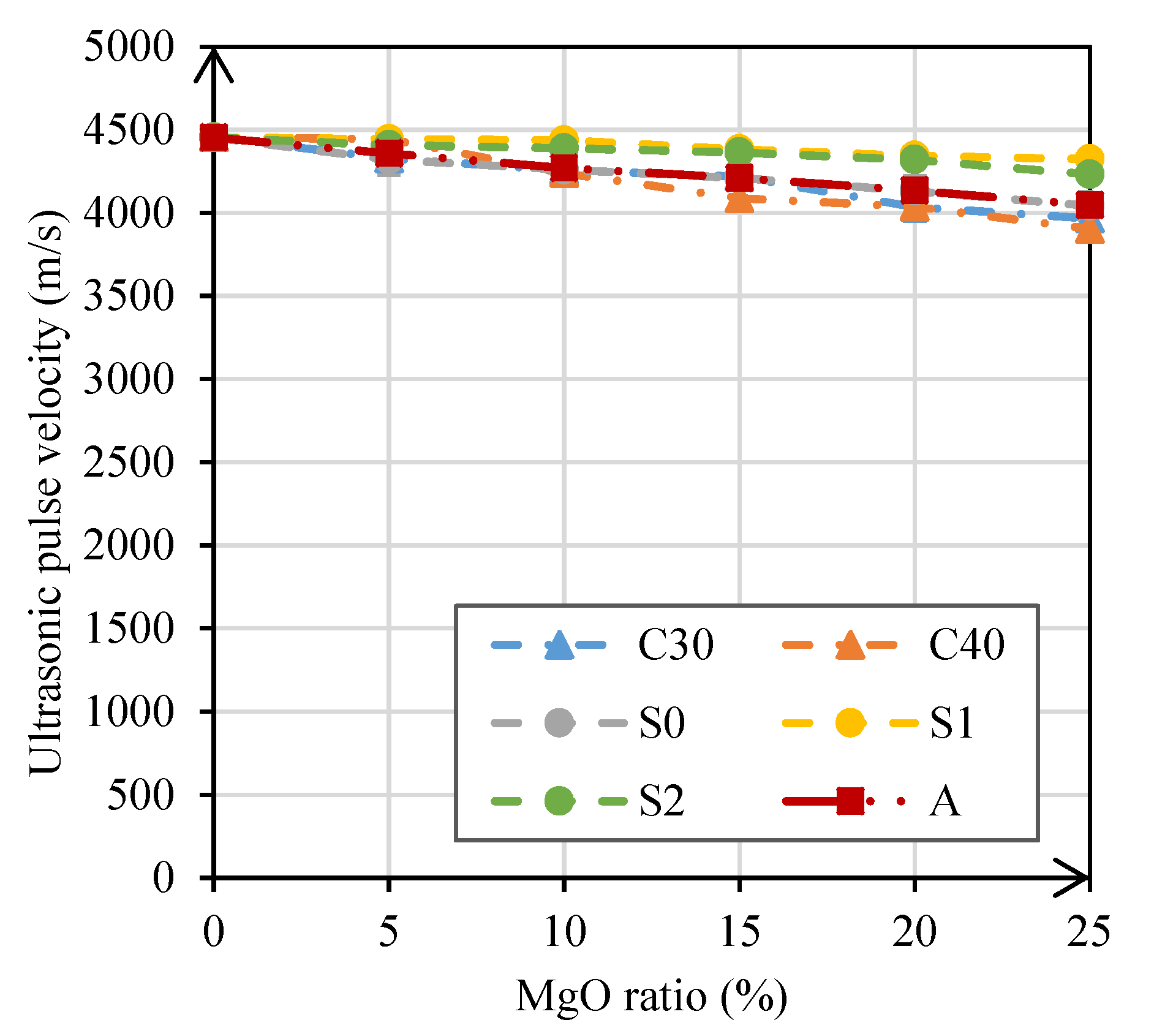
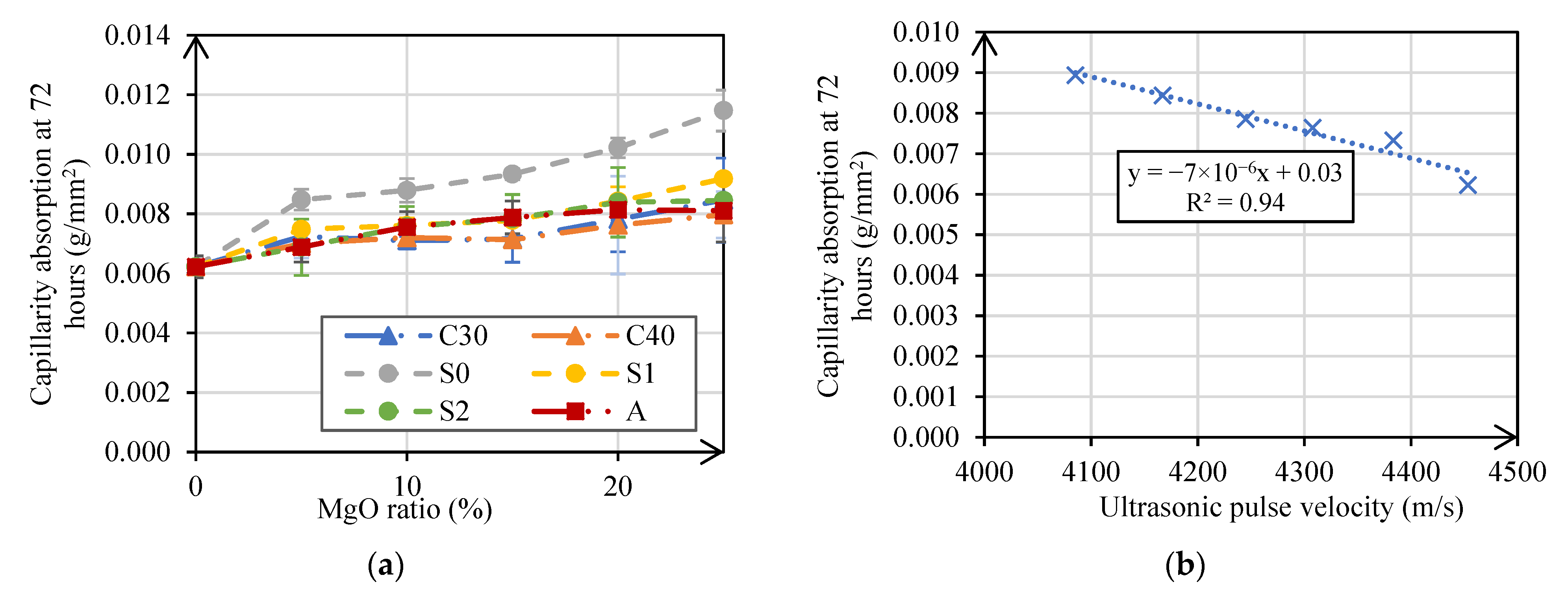
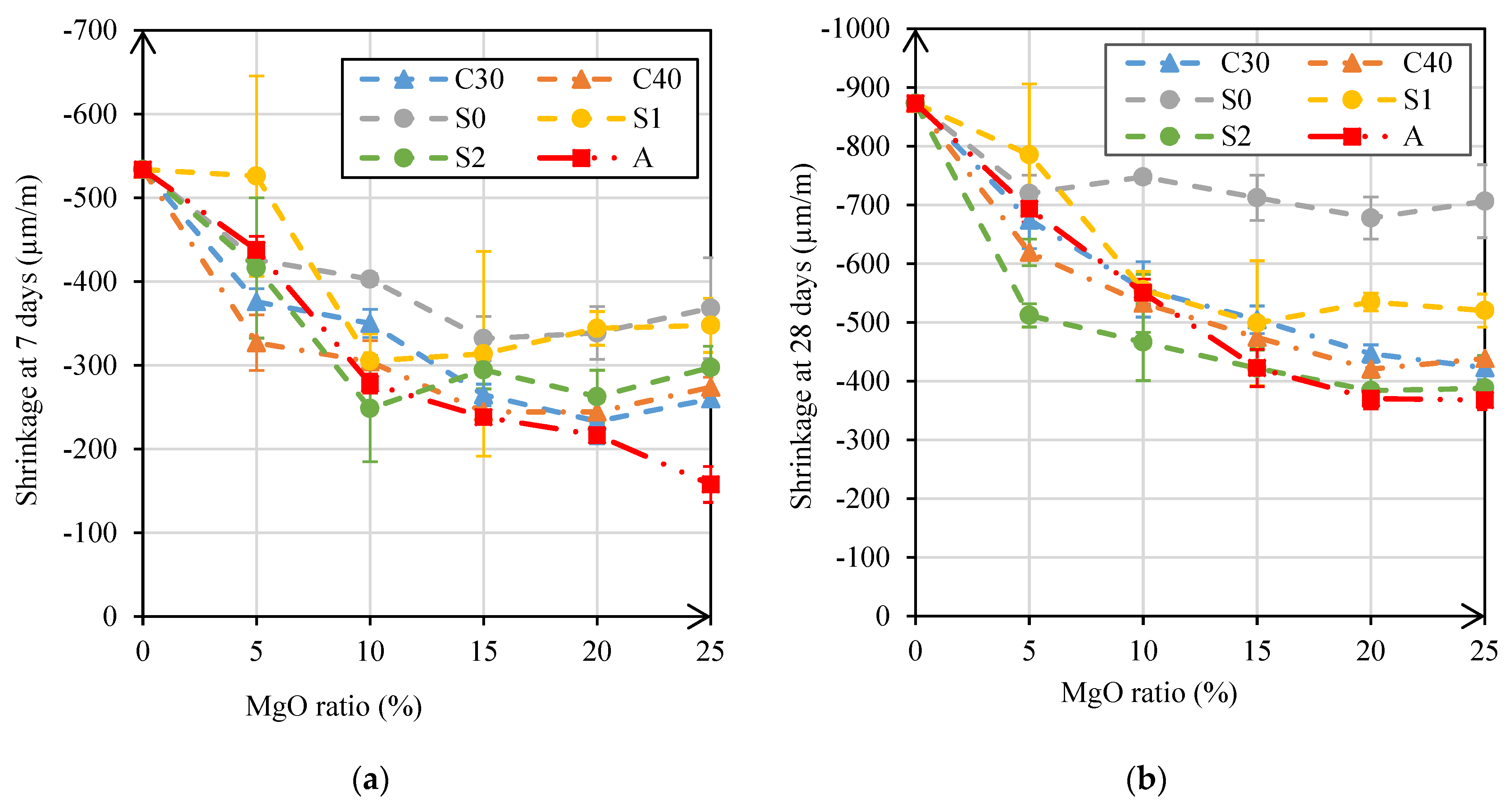

| Binder | MgO-S0 | MgO-S1 | MgO-S2 | MgO-C30 | MgO-C40 | MgO-A | Cement |
|---|---|---|---|---|---|---|---|
| Purity (%) | 85.0 | 86.3 | 86.2 | 95.9 | 96.0 | 98.8 | - |
| Specific surface (m2/g) | 4.9 | 3.0 | 2.6 | 28.6 | 47.9 | 51.2 | 2.8 |
| Reactivity (s) | 3544 | 1460 | 1777 | 21 | 16 | 14 | - |
| Properties of Mortars | Compressive Strength at 28 Days | Flexural Strength at 28 Days | Dynamic Modulus of Elasticity | Ultrasonic Pulse Velocity | Water Absorption by Capillarity | Shrinkage at 91 Days |
|---|---|---|---|---|---|---|
| RM | 58.3 MPa | 7.2 MPa | 35.8 GPa | 4453.3 m/s | 6.22 × 10−3 g/mm2 | −909.3 µm/m |
| M5-A | −17% (--) | −17% (--) | −1% (-) | −2% (-) | +11% (--) | −16% (+) |
| M5-C30 | −21% (--) | −24% (--) | −14% (--) | −3% (-) | +16% (--) | −22% (+) |
| M5-C40 | −6% (--) | −13% (--) | 0% | 0% | +12% (--) | −23% (+) |
| M5-S0 | −2% (-) | +3% (+) | −2% (-) | −3% (-) | +36% (--) | −19% (+) |
| M5-S1 | −9% (--) | −1% (-) | 0% | 0% | +20% (--) | −3% (+) |
| M5-S2 | −9% (--) | 0% | −1% (-) | −1% (-) | +11% (--) | −41% (+) |
| M5 average | −11% (--) | −8.3% (--) | −3% (-) | −2% (-) | +18% (--) | −21% (+) |
| M15-A | −28% (--) | −32% (--) | −6% (-) | −5% (-) | +11% (-) | −16% (+) |
| M15-C30 | −32% (--) | −30% (--) | −12% (-) | −5% (-) | +15% (-) | −39% (+) |
| M15-C40 | −31% (--) | −23% (--) | −12% (-) | −8% (-) | +15% (-) | −43% (+) |
| M15-S0 | −15% (-) | +1% (+) | −3% (-) | −5% (-) | +50% (--) | −20% (+) |
| M15-S1 | −13% (-) | −11% (-) | −4% (-) | −2% (-) | +25% (--) | −40% (+) |
| M15-S2 | −12% (-) | −11% (-) | 0% | −2% (-) | +26% (--) | −54% (+) |
| M15 average | −22% (--) | −18% (--) | −6% (-) | −5% (-) | +24% (--) | −35% (+) |
| M25-A | −39% (--) | −32% (--) | −1% (-) | −9% (-) | +30% (--) | −54% (+) |
| M25-C30 | −47% (--) | −31% (--) | −20% (-) | −11% (-) | +36% (--) | −55% (+) |
| M25-C40 | −49% (--) | −23% (-) | −19% (-) | −12% (-) | +28% (--) | −50% (+) |
| M25-S0 | −29% (--) | −7% (-) | −8% (-) | −9% (-) | +84% (--) | −21% (+) |
| M25-S1 | −28% (--) | −14% (-) | −5% (-) | −3% (-) | +48% (--) | −39% (+) |
| M25-S2 | −28% (--) | −17% (-) | −8% (-) | −5% (-) | +36% (--) | −60% (+) |
| M25 average | −37% (--) | −21% (-) | −10% (-) | −8% (-) | +44% (--) | −47% (+) |
Publisher’s Note: MDPI stays neutral with regard to jurisdictional claims in published maps and institutional affiliations. |
© 2021 by the authors. Licensee MDPI, Basel, Switzerland. This article is an open access article distributed under the terms and conditions of the Creative Commons Attribution (CC BY) license (http://creativecommons.org/licenses/by/4.0/).
Share and Cite
Bravo, M.; Forero, J.A.; Nobre, J.; de Brito, J.; Evangelista, L. Performance of Mortars with Commercially-Available Reactive Magnesium Oxide as Alternative Binder. Materials 2021, 14, 938. https://doi.org/10.3390/ma14040938
Bravo M, Forero JA, Nobre J, de Brito J, Evangelista L. Performance of Mortars with Commercially-Available Reactive Magnesium Oxide as Alternative Binder. Materials. 2021; 14(4):938. https://doi.org/10.3390/ma14040938
Chicago/Turabian StyleBravo, Miguel, Javier A. Forero, José Nobre, Jorge de Brito, and Luís Evangelista. 2021. "Performance of Mortars with Commercially-Available Reactive Magnesium Oxide as Alternative Binder" Materials 14, no. 4: 938. https://doi.org/10.3390/ma14040938
APA StyleBravo, M., Forero, J. A., Nobre, J., de Brito, J., & Evangelista, L. (2021). Performance of Mortars with Commercially-Available Reactive Magnesium Oxide as Alternative Binder. Materials, 14(4), 938. https://doi.org/10.3390/ma14040938










